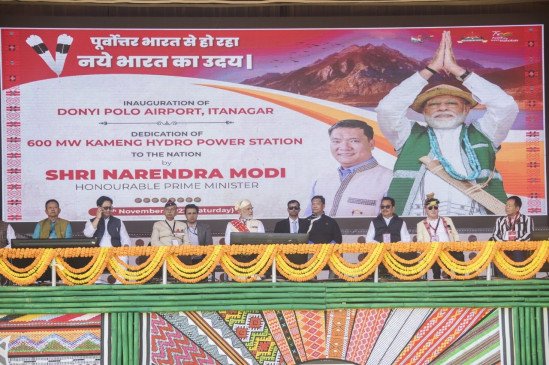Arunachal Pradesh, another northeastern state after Tripura, has become a power surplus state after Prime Minister Narendra Modi dedicated the 600 MW Kameng Hydro Power Plant to the nation at a function in Itanagar on Saturday.
The 600 MW Kameng Hydro Power Plant was developed by state-owned North Eastern Electric Power Corporation at a cost of over Rs 8,450 crore and is spread over an area of over 80 km in West Kameng district of Arunachal Pradesh. It is at a distance of 90 km from Tezpur in Assam.
The newly constructed hydropower project will not only make Arunachal Pradesh a power surplus state, but will also benefit the national grid in terms of grid stability and integration, a senior NEEPCO engineer told IANS. The engineer, who did not wish to be named, said the project would make a major contribution towards fulfilling the country’s commitment to adopt green energy.
He said that despite the Cabinet Committee on Economic Affairs (CCEA) approving the Kameng Hydro Power project in 2004 with an estimated expenditure of about Rs 2,497 crore, the project cost has shot up to Rs 8,450 crore due to delay in commissioning the huge power plant. .
According to NEEPCO officials, major design changes of primary structures, geological surprises, devastating flash floods, contractual issues, law and order problems delayed the commissioning of the project, which was to be completed by 2009.
The Kameng Power Project is a run-of-river scheme that will harness the flow of the Bichom and Tenga rivers (both tributaries of the Kameng River) at a gross head of 536 meters available below the Bichom River’s confluence with the Kameng.
The project consists of two dams – Bichom and Tenga. The water is carried through a head race tunnel. The present installed capacity of the Corporation is 2057 MW, which includes 1525 MW in Hydro, 527 MW in Thermal and 5 MW in Renewable (Solar) and the PSU located at Shillong (Meghalaya) generates about 40% of the energy requirement of North East India.
Official documents of NEEPCO state that Arunachal Pradesh has the potential to generate about 70,000 MW of hydropower, which is considered the powerhouse of India.
Tripura, the first northeastern state to become a power surplus state in 2013-14, when the state-owned Oil and Natural Gas Company set up the Palatana Power Plant, the northeast’s 726 MW thermal power plant at Udaipur in southern Tripura.
The Rs 10,000-crore Paltana power plant is a unique example of collaboration between New Delhi and Dhaka, which ensured the passage of heavy project equipment and turbines to Paltana in southern Tripura through Bangladesh territory. Tripura has been supplying 160 MW of power to Bangladesh from the Paltana power project.




